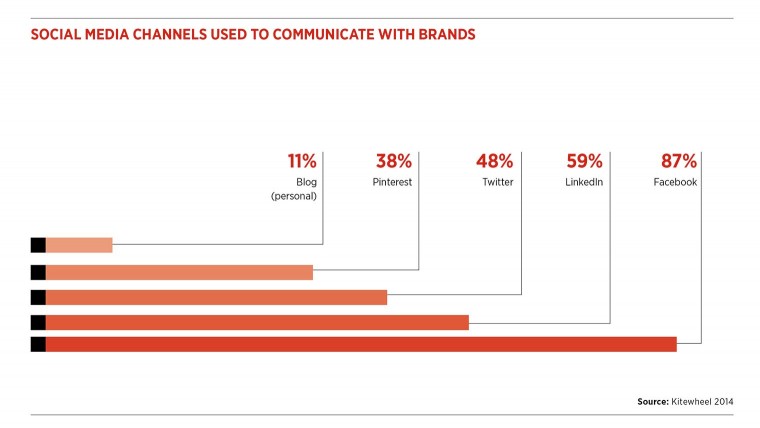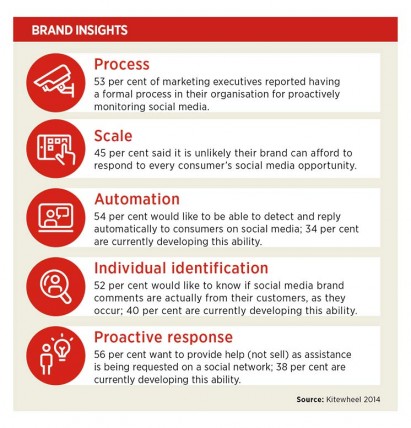British Airways’ slogan is “To fly. To serve.” The stark choice of words not only sticks in people’s minds, it puts service at the heart of what it does. But in 2013, the airline felt the full force of what is possible when someone is unhappy with service in the age of the social media complaint.
Disgruntled businessman Hasan Syed took to Twitter to voice his frustrations at British Airways’ handling of his father’s lost luggage. “Don’t fly @BritishAirways, their customer service is horrendous,” he posted. But instead of simply tweeting to his followers, Mr Syed paid around $1,000 to have the tweet promoted – by the following day the tweet had 76,800 impressions and 14,600 engagements.
The incident is the perfect example of how powerful consumers have become. It they aren’t happy, they can make sure that a lot of people hear about it.

“Social media has redefined the relationship between customers and brands,” says Merinda Peppard, Europe, Middle East and Africa marketing director, at Hootsuite. “Consumers have a voice and they expect to be heard. A careless strategy can leave your company exposed to online ridicule.”
As terrifying as this may seem, brands shouldn’t shy away from social media, it also presents a huge opportunity to communicate with customers. Social media has become one of customers’ favourite places to engage with brands.
The way you manage a brand’s social media efforts will affect the company’s bottom line as those conversations, customer care issues and opportunities to connect, convert into sales
Research by BT found that while five years ago forums made up 84 per cent of social interactions with brands, now that figure is just 2 per cent. Facebook and Twitter have become the dominant channels, and social media now makes up 74 per cent of total interactions with brands.
“Why should a brand use social media? Put simply, social media is where the customers are,” says Blake Cahill, global head of digital at Philips. “It’s where they talk about your brand and the topics that matter to them. If a company doesn’t become part of that conversation, whether it’s positive or negative, they lose the opportunity to shape the discussion and engage with customers on a level beyond simple product marketing.
“Ultimately, the way you manage a brand’s social media efforts will affect the company’s bottom line as those conversations, customer care issues and opportunities to connect, convert into sales.”

Sure enough, Bain & Company research found that customers who engage with companies over social media spend an average of 30 per cent more than they would do with another company. By chatting with people on social channels, companies can not only resolve issues quickly, but if they’re clever about it, they can surprise and delight with positive and witty messaging.
Back in 2012, O2 proved how true this can be by turning around what could have been a social media disaster into a triumph. A widespread network issue, lasting two days, sent thousands of cheesed-off customers on to Twitter, determined to vent their anger. Instead of hiding from the Twitter storm, O2 headed into the eye, responding honestly, openly and, where appropriate, with humour. Conversations about the brand eventually turned from complaints to huge praise and sympathy thanks to their efforts.
“The crucial factors in a social media strategy are being upfront and consistent,” says Nicola Millard, customer experience futurologist at BT Global Services. “Approaches to social media strategy vary greatly from sector to sector and business to business; some like to answer pretty much everything, while more sensitive sectors such as banking may feel it prudent to direct queries to less public channels. But an openness to talk is key.”
The best way to manage and analyse your customer relationships on social is to use an effective social media management tool
Another key factor in creating a successful social media strategy is speed and efficiency. A study by Lithium Technologies found that 53 per cent of people expect a brand to respond to tweets within an hour. Unfortunately, recent research by Brand Watch found that only 11.2 per cent of brands respond to questions within 60 minutes, so there is work to be done. Having a dedicated social media customer service team is one way to ensure messages get spotted quickly.
Social media strategies can be about a lot more than simply reacting to and engaging with customers. Social media holds a mine of data which is just waiting to be analysed. If this is done well, companies can learn a lot about their own brand reputation and that of their competitors.
There are many tools to use to look closely at the data produced by social media. Hootsuite is at the forefront of this.
“The best way to manage and analyse your customer relationships on social is to use an effective social media management tool to listen and monitor all your social channels, and alert the correct departments to inquiries in real time,” says Ms Peppard. “This not only allows you to maintain a two-way dialogue with your customers, but also monitor brand mentions.”
Twitter understands the power of customer data for brands. Never has this been more apparent, however, than this summer when it announced it was launching an API or application programming interface to give companies easy access to the entire back catalogue of tweets.
This is expected to give brands the opportunity to review tweets during advertising campaigns of old, during product launches gone by and see how unhappy customers where treated historically. This is a clear message to companies – analysis through social can lead to important insight.
Social media can help you, just as much as it can help your customers.
Case Studies
1. Dorchester Collection

Luxury hotel group Dorchester Collection not only knows how to charm customers with its crisp white sheets and polite doormen, its stellar customer service continues on social media. The company does this by interacting with its customers on social media, but also by analysing the data it provides.
“Over the past two years we’ve created a new reporting model which uses social media and online reputation to identify the main drivers of guest engagement,” explains Ana Brant, director for global guest experience and innovation. “From this we are able to alter guest experience strategies and employee development programmes to ensure every one of our ten hotels is achieving our business mission.”
Dorchester Collection analyses social conversations about the hotel group across Facebook and Twitter, which enables them to pinpoint keywords its guests use to describe their experiences with them. “We can look at the delighters and the setbacks, and innovate accordingly,” says Ms Brant.
The management consulting firm Gallup has a global luxury database and if hotels score 48 per cent in its fully engaged test, it pronounces them “world-class organisations”. Dorchester Collection scored 55 per cent.
“We have also been able to measure the link between customer focus and business performance over the past year,” adds Ms Brant. “Heightened guest engagement has resulted in significantly increased revenues; we’ve reduced the number of actively disengaged guests by responding to social feedback and have boosted social media followings on Facebook – 11,500 likes, Instagram – 20,000 followers and Twitter – 28,000 followers.”
2. Direct Line Group

Last year Direct Line Group launched a new brand proposition called Insurance that Simply Works. Keen to make sure this was a complete operational shift in the business, rather than a marketing campaign, the group makes sure social media customer service as at the centre of the new brand promise.
“From the outset, we made sure that social media wasn’t just the marketing team’s responsibility or just another channel in a media plan, but much more than that,” says Mark Evans, Direct Line Group’s chief marketing officer.
In practice, Direct Line can be impressive. During the summer it started responding to commuter gripes during the Tube strike by sending out care packages, including everything from donuts to refreshing foot spray and sun cream, using #EverydayFixes. The Twittersphere loved it.
Shortly after this Direct Line Group, which has 5,723 followers on Twitter, was named by Harvard Business Review and Lady Geek as the most empathetic brand on the social network.
Mr Evans puts Direct Line Group’s success down to investing in training, not just investing in commuter gifts. “The importance we place on customer service across social media is reflected in the way we choose and train our team,” he says. “We select employees from our customer services and claims departments to work solely on social media. We then spend time training them on everything from brand to marketing to social media, to ensure they are best equipped to deliver the strongest customer service.”
